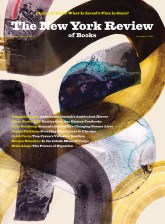In response to:
Unreasonable Terms from the October 5, 2023 issue
To the Editors:
In his review of journalist Alexander Zaitchik’s Owning the Sun: A People’s History of Monopoly Medicine from Aspirin to Covid-19 Vaccines [NYR, October 5], Daniel J. Kevles makes a significant error when he dismisses the central role of the National Cancer Institute (NCI) in developing the first anti-AIDS drug. He instead credits Burroughs Wellcome with identifying AZT as a potential therapeutic. It’s important to correct the record, because the federal government’s subsequent refusal to demand reasonable pricing for AZT set the pattern for the pharmaceutical industry price gouging that persists today.
As soon as an NIH-employed scientist (Robert Gallo) identified the retrovirus that caused AIDS, an NIH-funded postdoc (Hiroaki Mitsuya) created an assay for identifying drug candidates. NCI director Samuel Broder, whose subagency ran an extensive clinical trials network, then asked every major drug company for chemicals from their libraries for screening. Burroughs Wellcome responded by sending multiple candidates, as did several other companies. “They were not the only company that I visited, but to their credit, they were the first to make a serious commitment,” Broder told NIH historian Victoria Harden in a 1997 interview.
The NCI mass screening project identified AZT, a failed cancer drug that had been developed in 1964 by an NIH-funded scientist. At that point, Burroughs Wellcome scientists balked at handling the materials needed to conduct the preclinical and initial clinical trials. “They were extremely concerned” about their staff being infected, Broder told Harden. “They refused to accept live virus, and at one point refused to accept patient samples. That was a little unusual. They basically put the entire onus…on NCI.” The successful development of AZT triggered research into other anti-AIDS drugs, also with government help, and eventually led to the development of lifesaving combination therapy.
I join Kevles in his call for reasonable prices for medicines and his condemnation of Big Pharma putting greater profits over that basic human rights obligation. However, obscuring the crucial role government played in what is arguably the most important medical advance of the past half-century makes achieving that goal more difficult.
Merrill Goozner
Chicago
Daniel J. Kevles replies:
The significant error is not mine but Merrill Goozner’s, in saying that it was the NCI rather than Burroughs Wellcome that first identified AZT as “a potential therapeutic” against HIV. Nowhere in Broder’s interview with Victoria Harden, Goozner’s only declared source, did he claim that priority for the NCI. More important, according to the factual record in two AZT patent cases from 1993 and 1994,* at the end of October 1984 Burroughs Wellcome began testing various compounds for activity against mouse viruses similar to HIV and by early December had observed that AZT prevented the mouse viruses from replicating. The company was sufficiently confident of AZT’s likely efficacy against HIV that by February 6, 1985, it had completed the draft of an application for a patent on AZT that included a range of dosages for the treatment of HIV infection. Two days earlier, it had sent AZT under the code name Compound S to the NCI for testing against live HIV. At the time, Hiroaki Mitsuya, the NCI scientist who had developed the live-virus test and used it to assess Compound S—the results were positive—had never heard of AZT, and Broder had not thought of using it against HIV.
Still, Goozner reinforces the point made by me and others that NCI’s contributions to the development of AZT as an anti-HIV drug were substantial, likely sufficient to warrant coinventor status on Burroughs Wellcome’s patents; but Broder had let slip the opportunity to claim that status when his lab did the work in the mid-1980s. NIH did not receive it in the later patent cases and had no say ever in the pricing of the drug.
This Issue
December 7, 2023
No Endgame in Gaza
Invasion, Day by Day
Gut Instincts
-
*
Burroughs Wellcome Co. v. Barr Laboratories, Inc. et al. (1993); Burroughs Wellcome Co. v. Barr Laboratories, Inc. et al. (1994). ↩



